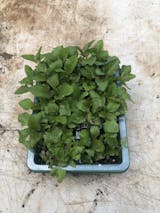Toothache Plant/Lemon Drops (Paracress)
- Lemon Drop (Spilanthes/Toothache Plant) - Vibrant yellow, 1-2" diameter, mildly fragrant blossoms.
- Produces flowers freely from early through late summer.
- Flowers and leaves contain spilanthol, an analgesic for numbing toothaches.
- Handles high temperatures and summer well.
- Deer resistant, attractive to bees and butterflies.
- Acmella oleracea.
- 120 days to maturity.
- 1 gram per packet.
Description
Also known as spilanthes or the toothache plant, Lemon Drop has vibrant yellow, 1-2” diameter, mildly fragrant blossoms that are produced freely from early through late summer atop a clump of fast and low growing, narrow and linear, dark green foliage. The flowers and leaves contain spilanthol, an analgesic used medicinally for numbing toothaches. The blooms handle the high temperatures and summer very well. The plant is deer resistant, yet is very attractive to bees and butterflies. Acmella oleracea. 120 days to maturity. 1 gram per packet.
Lemon drop prefers warm weather and full sun, and requires drier, well-draining soil. The blooms can be picked at any time but it's best to wait until the plant reaches several inches in height before harvesting. Continue to pick the flowers during and after blooming. Use fresh blooms for the best flavor, or preserve in a glass jar for up to a year, or as long as the flowers have good color. Faded herbs have lost their potency and should be composted once the color is lost.
For more growing information, check out our Growing Guide!
Lemon Drop Planting Information
Planting Method: transplant or direct seed
When to Plant: early spring
Planting Depth: 1/4"
Seed Spacing: 6-12"
Row Spacing: 12-18"
Days to Maturity: 120 days
Disease Resistance: n/a





